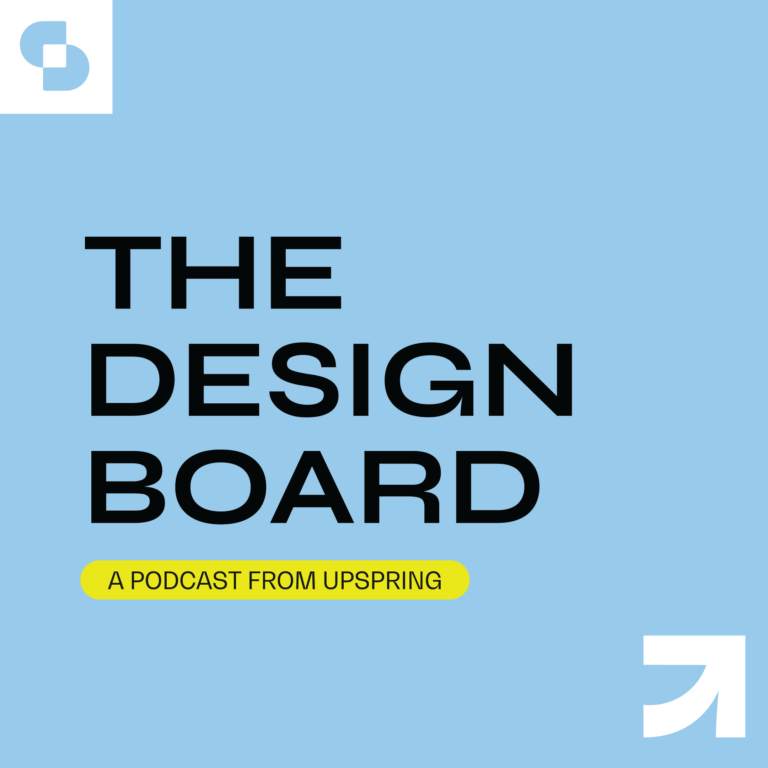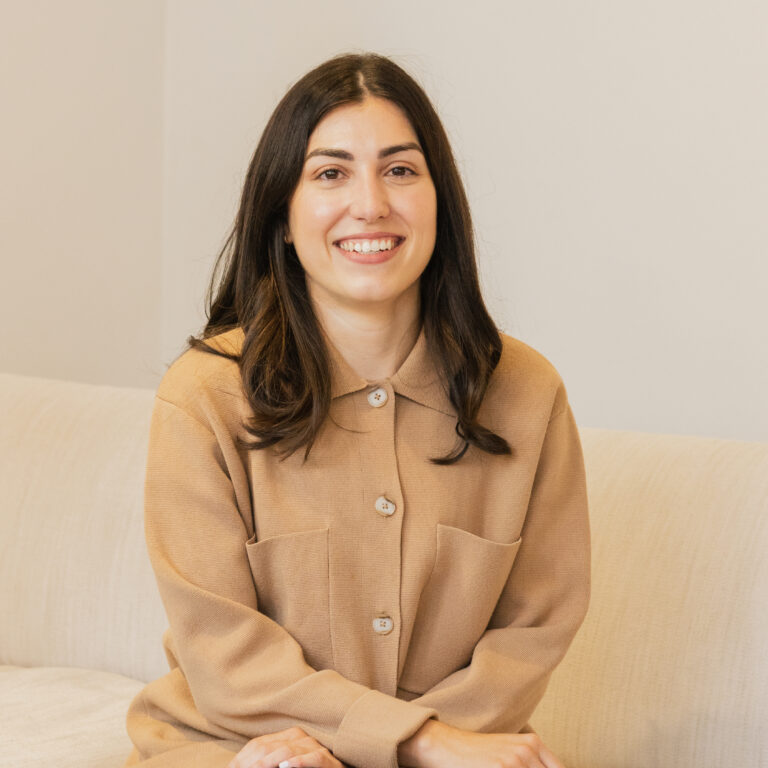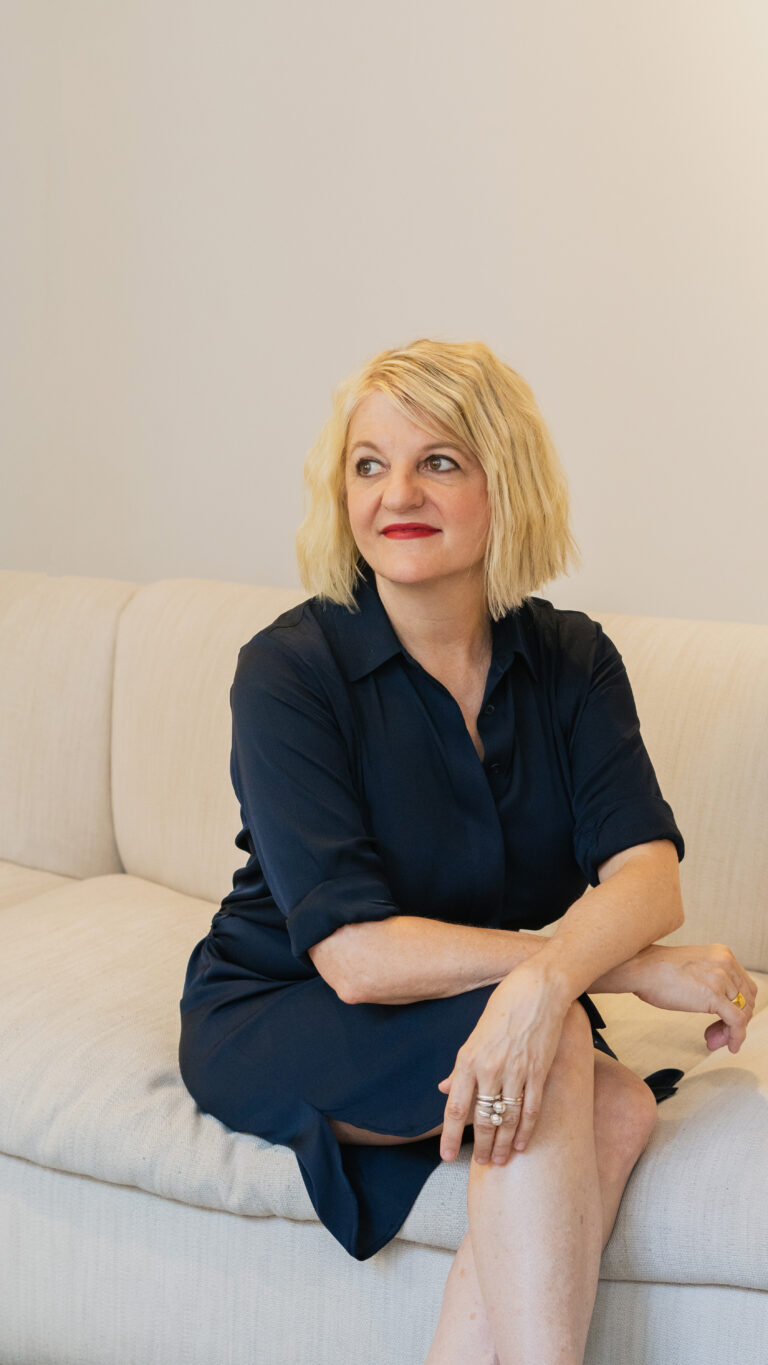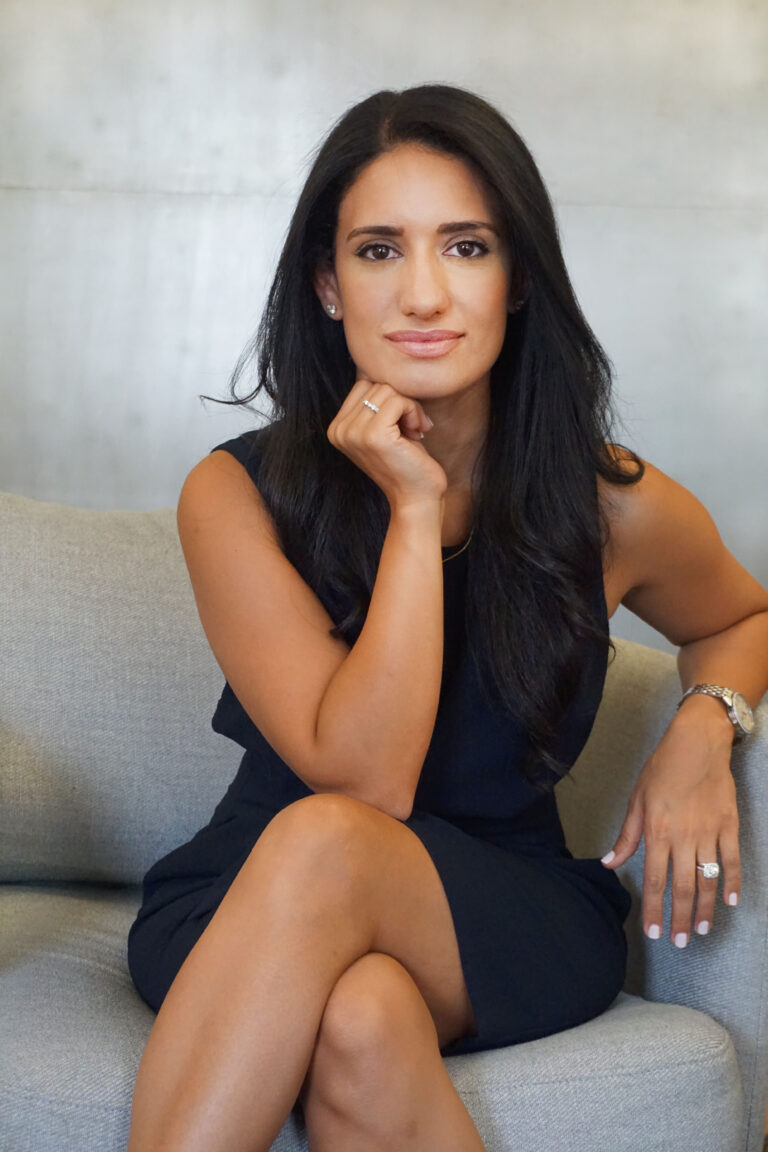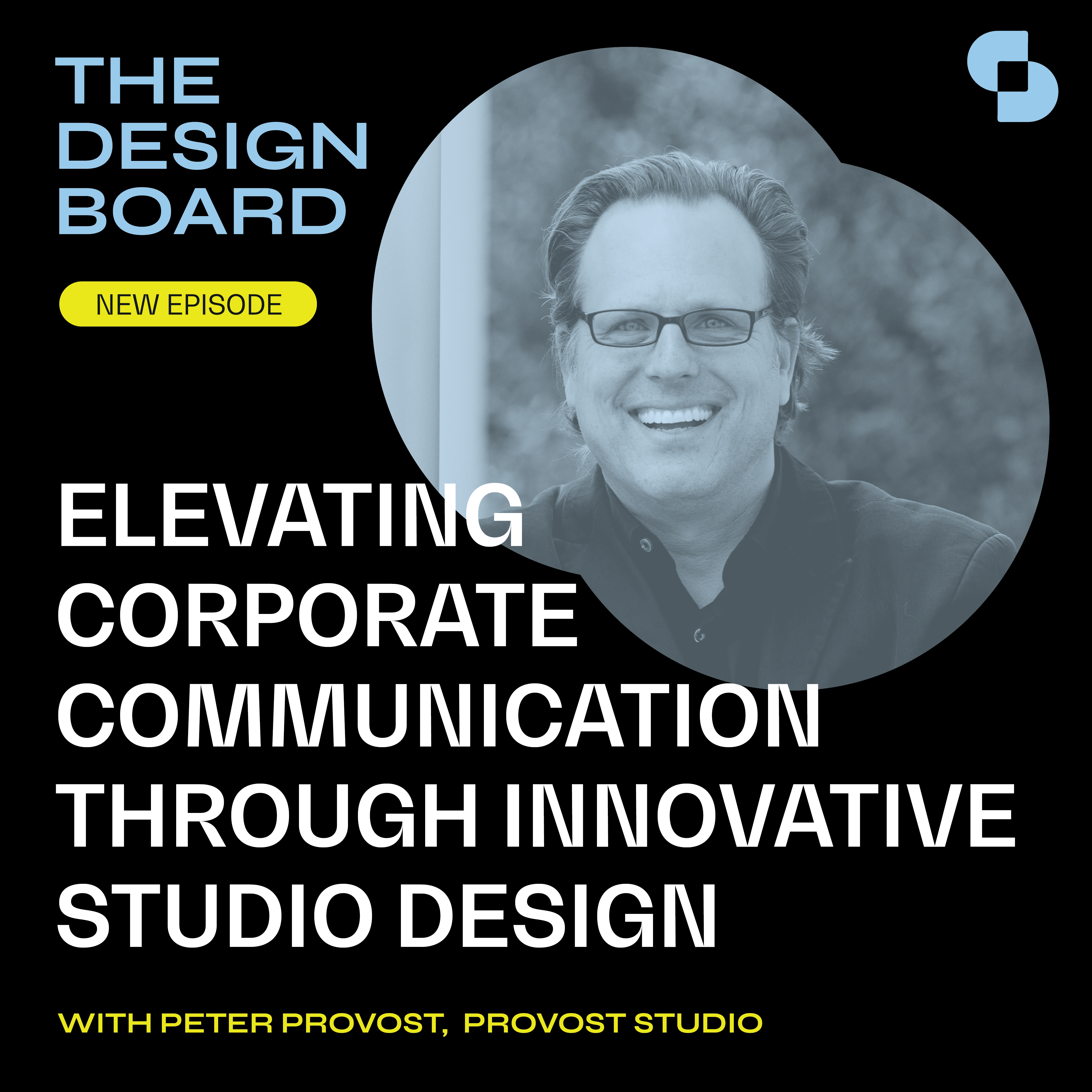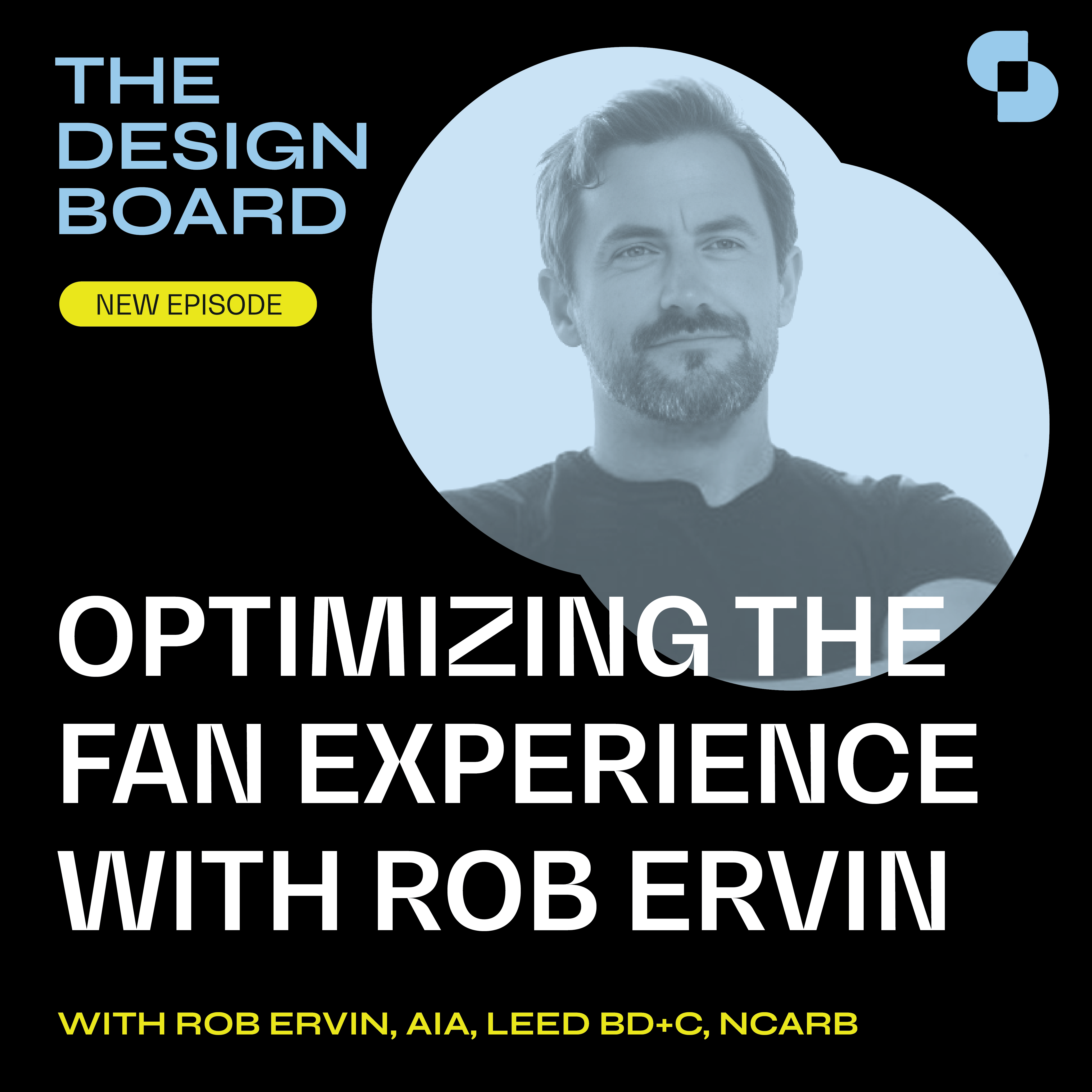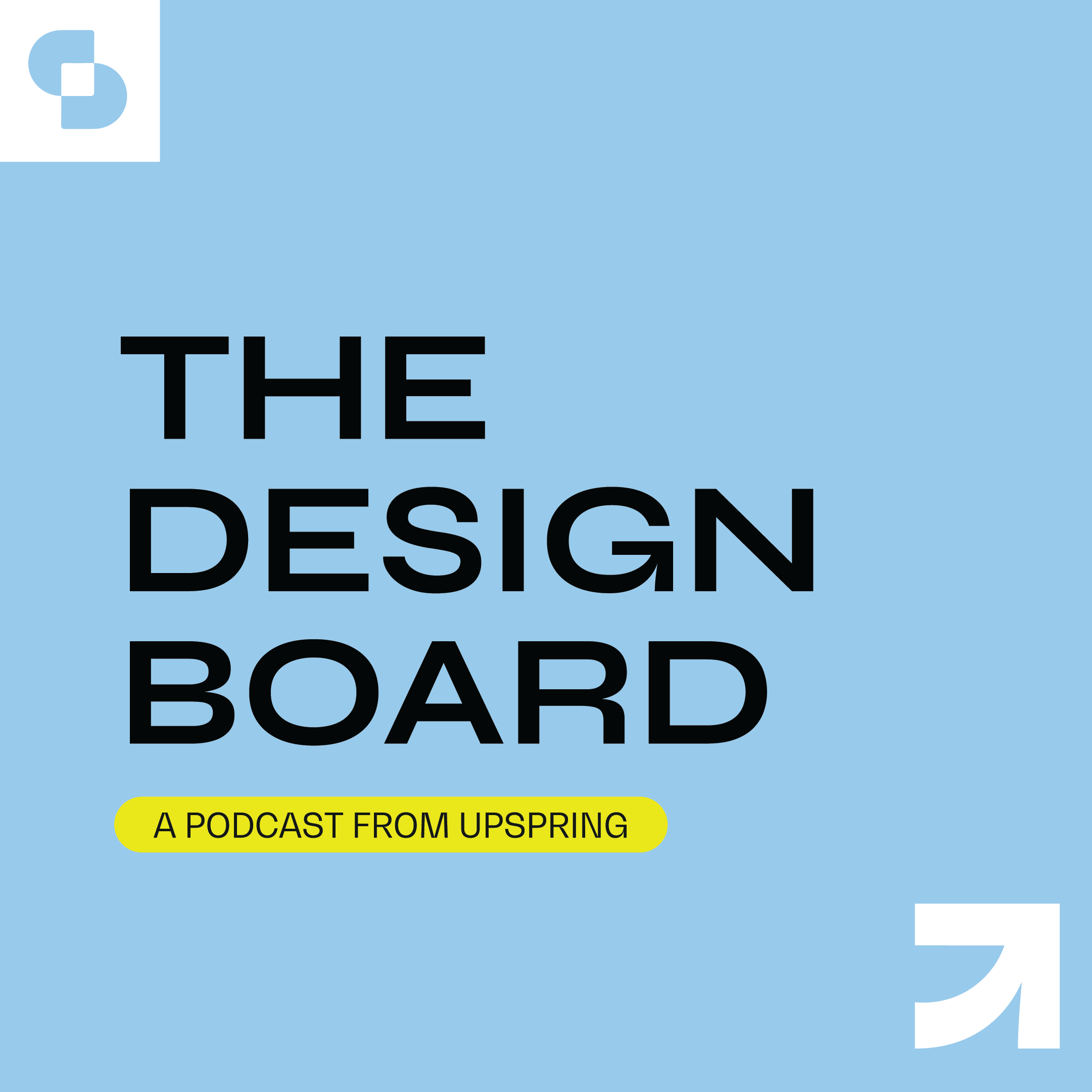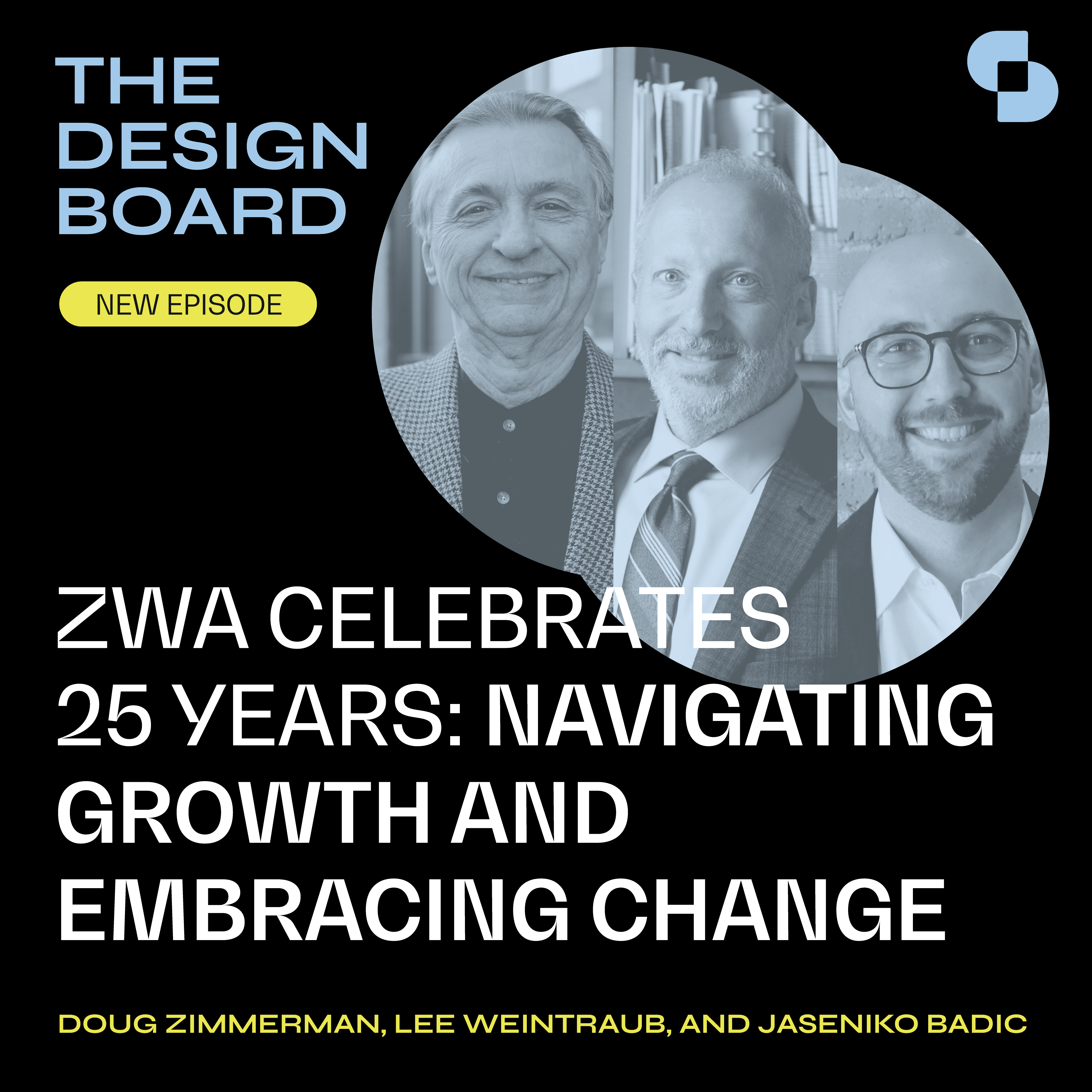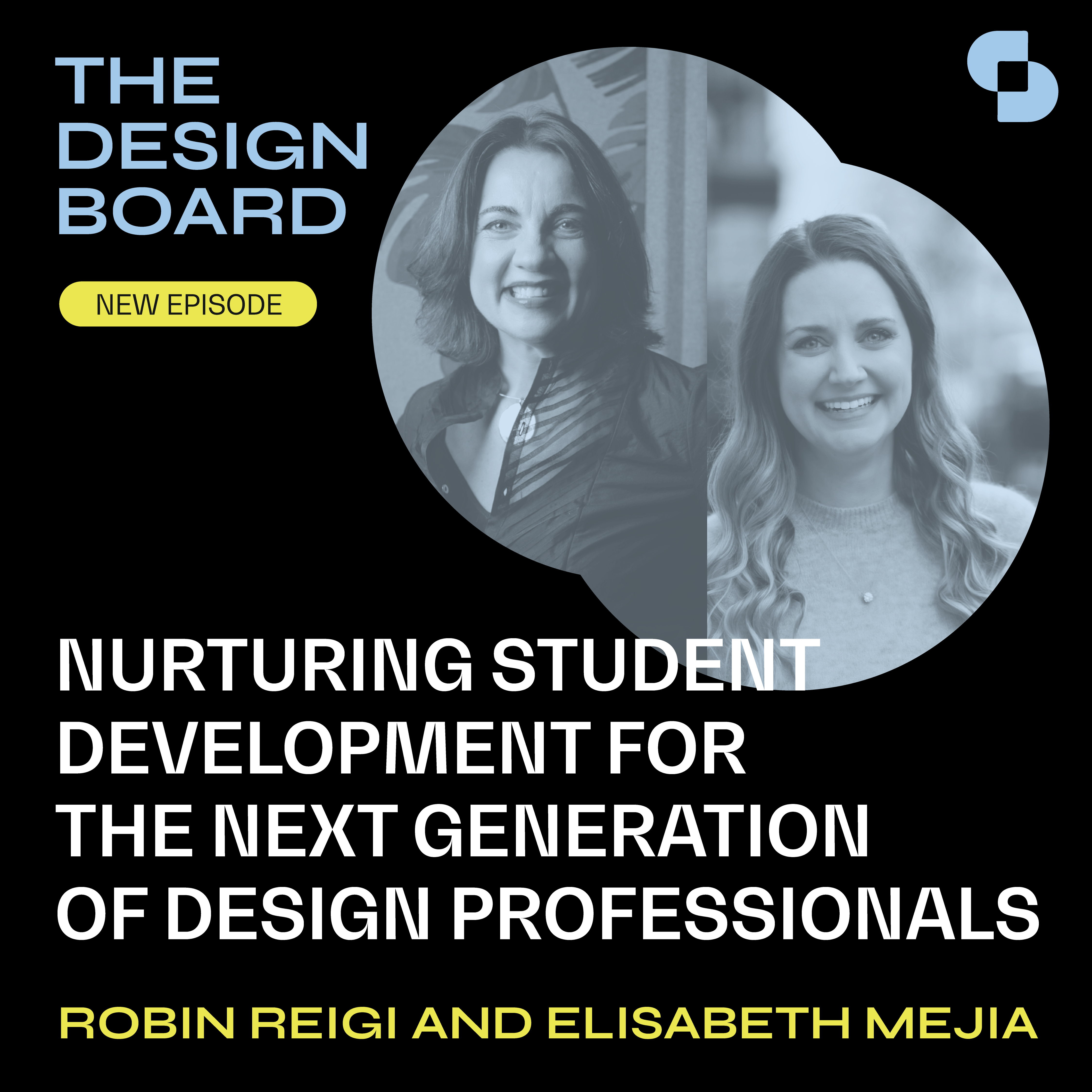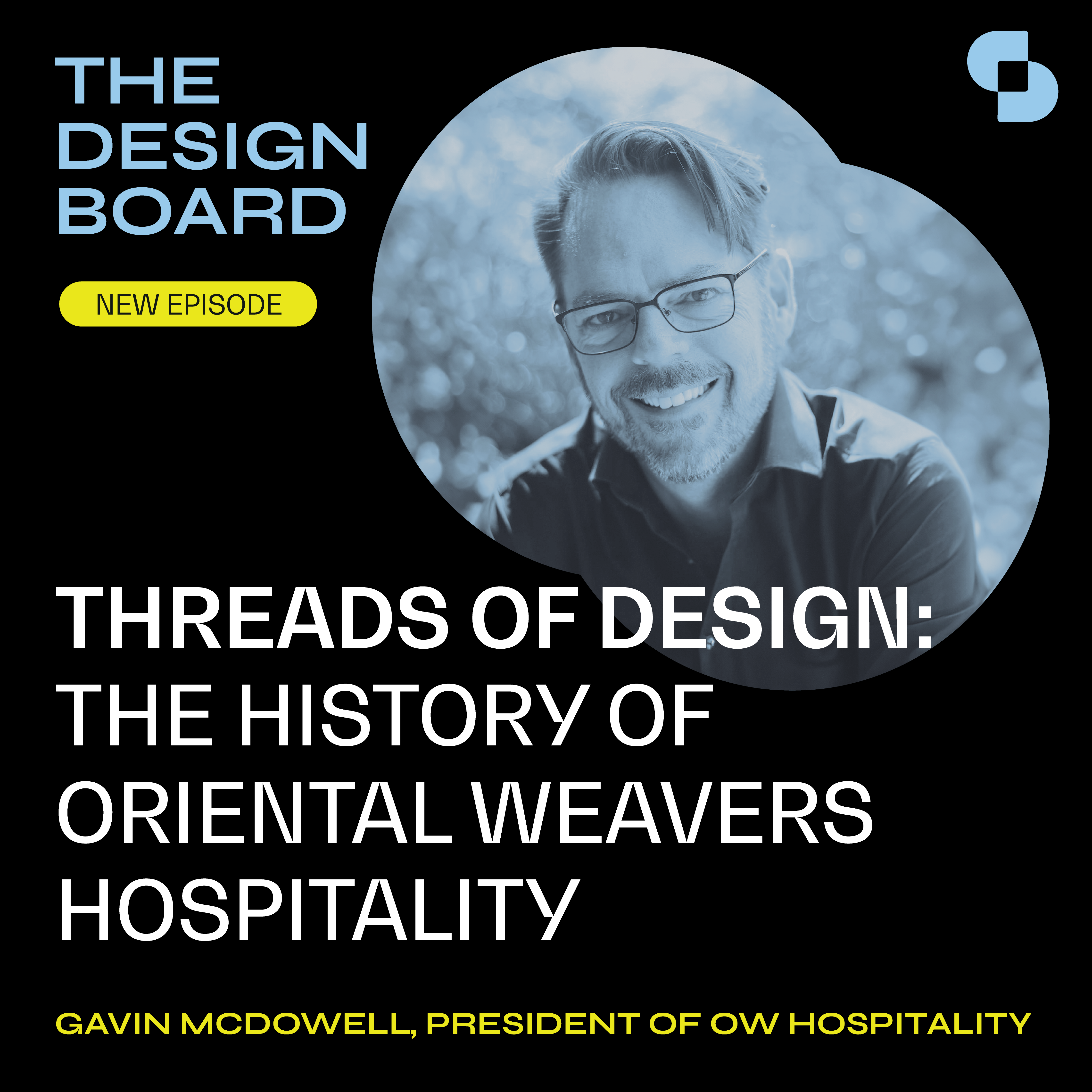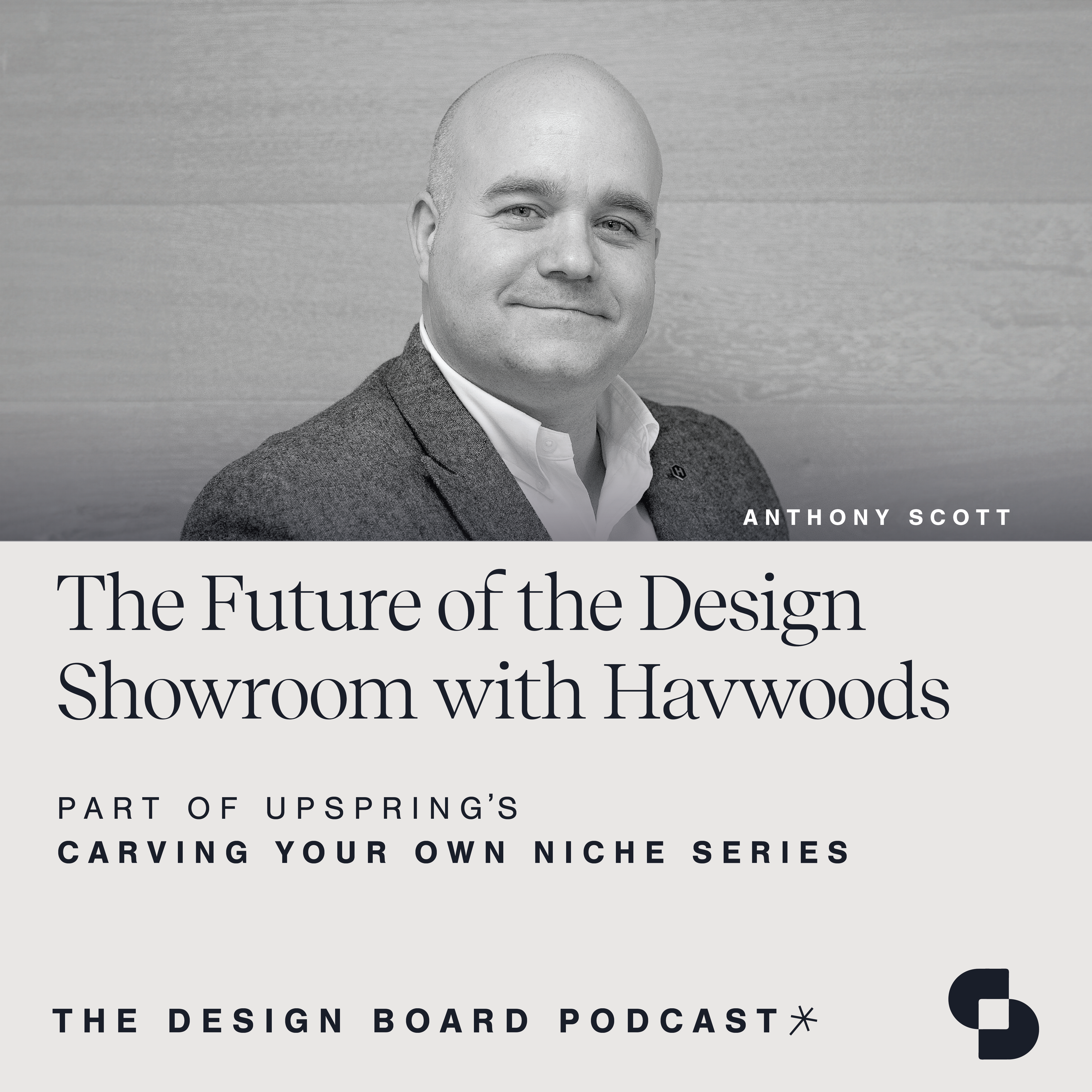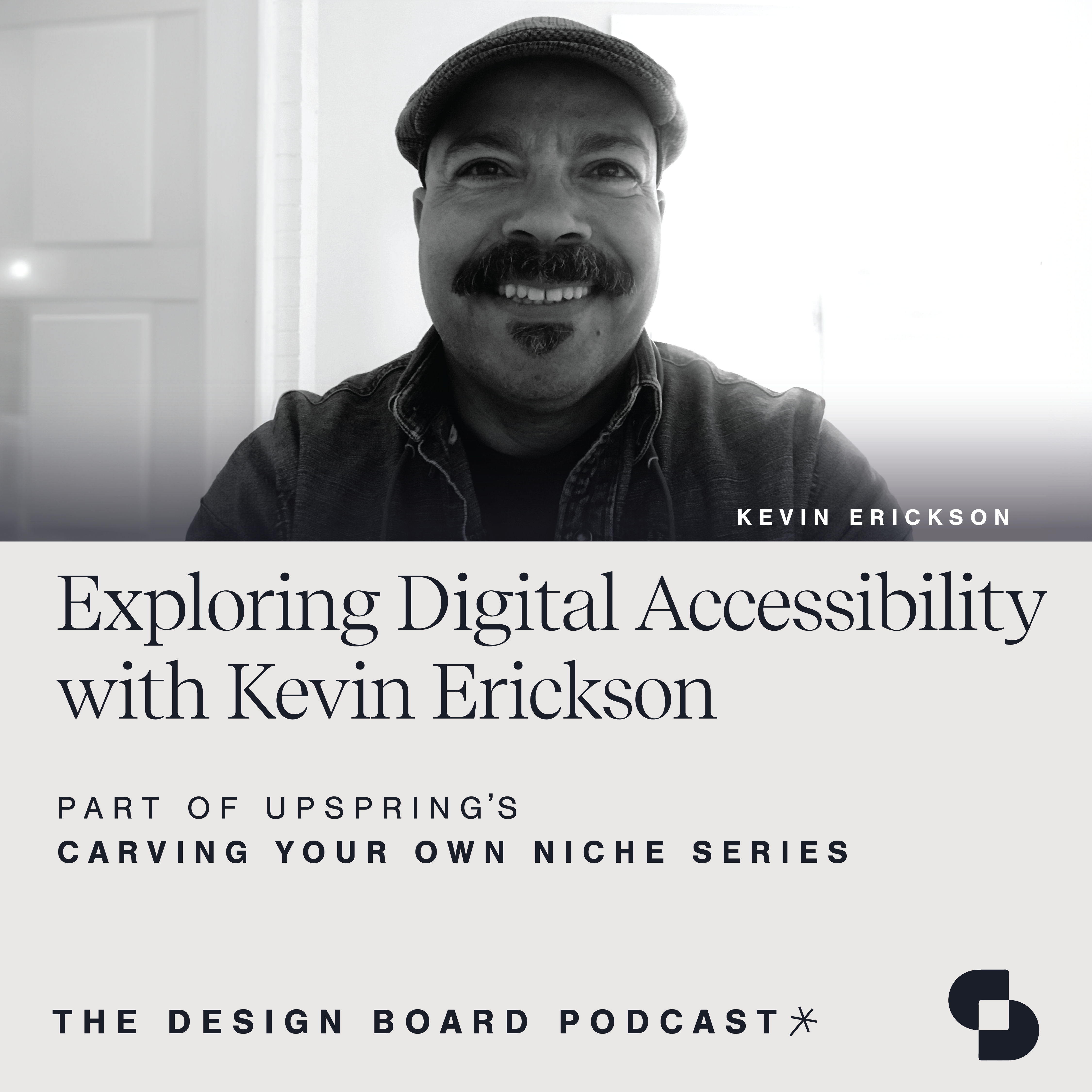In this week’s episode, we sit down with the visionary founder of Buster + Punch, Massimo Buster Minale. From architecture to custom motorcycle building, Massimo’s journey is a testament to the power of blending passions. Massimo discusses the importance of authenticity and shares how his experience and background have shaped the distinctive niche that Buster + Punch has today.
The Design Board, by UpSpring, is a proud member of SANDOW Design Group’s SURROUND Podcast Network, home to the architecture and design industry’s premier shows.
Speaker 1:
Welcome to the Design Board, a podcast created by the team at Upspring that focuses on design, development and everything in between. We invite innovators in our industry and explore topics that support your growth in every way. The Design Board is a proud member of Surround, a podcast network from Sandow Design Group featuring the architecture and design industry’s premier shows. Check it out at surroundpodcast.com.
Speaker 2:
Welcome everyone to the Design Board, a podcast by Upspring that focuses on design, development and everything in between. We host innovators in our industry and explore topics that support your growth in every way. Today we have Massimo Bustaminali with us, the mastermind behind the iconic brand, Buster & Punch. Massimo’s journey is a riveting tale of creativity and the courage to make a drastic pivot. Buster & Punch is a London-based design studio known for its innovative approach to solid metal lighting, furniture, and architectural hardware. With a background in architecture, industrial design, and handcrafting custom motorbikes, Massimo has gained global recognition for his distinctive aesthetic. Massimo’s commitment to pushing design conventions with creative digital and physical content has captivated an audience that seeks a brand experience beyond merely a product. His work reflects a fusion of craftsmanship, precision, and bold creativity drawing from an electric mix of cultural inspiration.
All right. Well, we are excited to hop right in. So Massimo, thank you so much for joining us today. Your journey from architect to custom motorcycle builder to the founder of Buster & Punch is quite unique. Can you share a little bit about how Buster & Punch was born?
Massimo Bustaminali:
Yeah, sure. I’m a trained architect, so I was living in London as an architect for many years. I sort of, I guess got frustrated with architecture. It’s a very slow but noble career choice and sort of threw myself into my pastime, which was basically making motorbikes and making product and making things in a garage in East London. And I guess, yeah, I by the day was an architect and then by night was making motorbikes and really enjoyed the fastness of creating things and building things and driving fast things a lot more than my slow day job. So slowly I sort of just threw myself into that world more and actually started to make little things and bikes for people and product, and it got to the stage where I could finally quit the day job and really followed the stuff that I loved. And basically, my creative outlet was Buster & Punch, which was the brand I created off the back of that.
Speaker 2:
So Buster & Punch began in a garage in East London, is that correct?
Massimo Bustaminali:
Yeah, I mean, it sounds grandiose, but basically it was a little garage at the back of my house. I’m sure lots of companies and brands have started the same way. But yeah, basically started in a pretty horrible little garage in Dalston, which is not a very nice part of East London, but it’s lots of interesting people that live around there. So yeah, that’s basically where the brand was born.
Speaker 2:
I love it. How did that transition from custom motorcycles to metal design details unfold?
Massimo Bustaminali:
So basically, I mean, when I was an architect, what, some 15 years ago, architecture practices were just full of architects. They didn’t really care about the insides of buildings or the interiors of buildings. And when I was an architect, took it upon myself to specify and get people interested and excited in the interiors of these lovely buildings. So basically back in the day when I was an architect, I was trying to sort of find beautiful door handles and light switches and fitted fixtures and all these sorts of interesting little metal details that you find on the insides of houses. I really struggled with it. I could find a nice brass light switch in France, but couldn’t find the door handle to match. So I used to start making a lot of this stuff myself. So for example, when I was at Richard Rogers, we were prototyping door handles because we couldn’t find them on the market and I was making them in my garage.
I was making them in the same way that I was building parts for motorbikes. So it was all the same machinery, all the same sort of processes. So I think that my architecture world, I guess sort of melted into my motorbike metal working world, and they all sort of became the same thing. So I was making everything out the same metals. It kind of all looked and felt the same. And at the end of it, I guess Buster & Punch was born, which was the result of everything that was going on in the garage and in my head, which was basically fashioning lovely solid metal into interesting home details, into motorbikes, into products that people loved. And that’s kind of how I went from architecture to Buster & Punch. It was sort of quite a natural progression.
But I think my real passion was these two worlds and my creative outlet was Buster & Punch. It was a much faster paced, exciting creative life for me as a designer was essentially Buster & Punch, whereas architecture for me was a bit slow, so that became my focus. And the brand was born, gosh, 10 plus years ago now. Yeah.
Speaker 2:
That’s awesome. I mean, as a business owner, I know how hard it is, especially as the owner of a PR marketing agency, how hard it’s to build that following to really resonate with the buyer and really sort of build that following and that brand identity. So Buster & Punch is a bit of a cult-like following. What do you think sets your brand apart? What has contributed to its unique identity and what have you put into it over the last 10 years that you feel like has contributed to that growth?
Massimo Bustaminali:
I think firstly, we’ve sort of never acted like a traditional interiors brand. We’ve always sort of acted more like a fashion brand or a music band or a motorbike builder, and we’ve been just as interested in the products as much as the lifestyle and the world around it. We grew up as a brand at a time where all of our competitors looked the same. They were all making lovely products, but they were all marketing it the same way, cutting it out, putting it in magazines. They were all talking to the same sort of person, a wealthy person that owned a house. And we sort of came along and we did it very differently. We kind of turned our backs a little bit on the interiors world and the interiors world turned their backs on us as well, but we just acted differently for us from the very start.
As I said, it’s been a sort of creative outlet and it hasn’t just been about the product, it’s kind of been about the excitement of our community and our world around it. It’s been about the content, it’s been about the people that talk about it. It’s been about popular culture and subcultures and all those sorts of things. So I think that’s helped us get a bit of a cult-like following because we were very different. And I also think we benefited from having lots of interesting people and celebrities adopting our products and liking our products and talking about our products at a time when social media was just taking off. So we never did any traditional marketing. We sort of relied on word of mouth, we relied on people finding our product interesting, telling their friends that we also make motorbikes. Have you seen their new video? They launched a song on Spotify.
We were doing lots of different things within culture that weren’t just focused on, here’s a product, do you want to buy our product? It’s really nice. So we’ve always embraced, I guess, that original spirit and different spirit, and we’ve shouted in a way that’s different to the status quo. And I think people just sort of embrace that at a time when everything was kind of really dull in the interiors industry actually. It’s very different now, but when we started 13 years ago, it was a dull place to be. Everyone was doing the same thing. Everything was very nice. No one wanted to ruffle feathers. And I think we came along with a bit more of a punk attitude and talked in a different way with a different language to people that didn’t own homes, to younger people. And I think it just created a strong community. Yeah.
Speaker 2:
I mean that’s incredible. You really focused on, again, building that community and that lifestyle and it sounds like in every way, product aside, just focusing on being creators, right? Creators of everything that you felt and believed in. So I think that’s a really great lesson in really how to build community and build a following around a company, a product, a mission. Creating and maintaining individuality and authenticity is so important in today’s market. How did your upbringing in East London contribute to this, and how did it influence the unique niche that the brand occupies today?
Massimo Bustaminali:
I think firstly, sort of starting a brand or something unique and different was a lot easier. 15 years ago, 10 years ago, there was no Pinterest, there was no social media whacking around the head with the same images. Design brands were led by talented people rather than mountains of data. We started in a lovely corner of East London that was super creative community, fashion designers would live next to crack dens that would live next to motorbike builders and music bands and bankers and professional people. And it was just a really lovely melting hot of life. And we as a brand, I guess, took our uniqueness from the streets and from our community rather than looking at Pinterest or doing things that everyone else was doing. So I’d say it was a lot easier back then because everyone started from a blank page. People didn’t have all these ideas in their heads placed by social media and what they could see around them.
There was a lot less of product and a lot less consumerism. And I think brands were just a bit more tuned into their uniqueness and tuned into their unique environments. And we were just lucky enough to grow up and be a part of a subcultural world in East London that was exciting at the time, so many interesting fashion designers, Alexander McQueen. So many interesting street artists, so many interesting bike builders and music bands were coming out of that part of London. And we sort of tacked ourselves onto the back of that and took inspiration from that. And I think we were lucky in that respect. And actually, authenticity and originality and representing where you are from and what you’re about is kind of really, really important and probably a bit of a dying art now. So we’ve sort of held that really important to us. But yeah.
Speaker 2:
Well, it’s a lot. I mean, for anyone who knows Buster & Punch, it couldn’t be more clear that you embrace nonconformity. I would love to explore a little bit what role that has played in shaping the identity of Buster & Punch. How do you do that? How does one avoid conforming?
Massimo Bustaminali:
As a brand, actually, we do conform a lot, and part of our uniqueness and spirit is that we take very ordinary essential products, things like light switches and door handles and cabinet pools and things that are vital for your home. But we sort of wrap them in a world of excitement and subculture and great content and interesting people. And I think we’re kind of the interesting bit between conforming and actually non-conforming. I’m sort of old enough to understand a world where trends and interesting stuff essentially came from different ideas that you saw on the streets and different trends that were cultural embodied in a moment of time. And I think today we turn our back on trends as a company because we see trends as a bit of a waste of resource and waste of time.
We have never really been interested in trends. We’ve always been really excited and pride ourselves on being original and trying to be one step ahead of the trend. And we also kind of as a brand, design and build product that is, I guess, timeless. We don’t want to waste resource and look like everyone else. And yeah, I don’t know about the non-conformity thing. I think in some aspects we conform as much as anyone else and some we don’t. I think what we do hold true is this sort of idea of originality and an idea of not necessarily following trends and doing things slightly different. So yeah, I think that’s kind of where we got.
Speaker 2:
I’ve always personally had a hard time really understanding how product manufacturers or companies that develop design elements could focus on trends so heavily when the environments that we live and breathe in and stay in and work in are just so long-lasting. They’re not changing fast enough to maybe necessarily even shift with trends. So the authenticity involved in the development of a space that actually feels true to who you are and how you live is so important. And I really admire the fact that you all prioritize that.
Massimo Bustaminali:
Well, yeah, I mean trends is a really interesting topic generally because as I sort of alluded to, I do remember a time when trends were led by young, talented, interesting people. There were things that were happening on the streets and in our communities. And nowadays, trends are essentially led by large companies, large behemoth companies that pay lots of money for you to see the same white bosley sofa over and over and over again on Instagram. And it’s not a word that I would associate with the originality of the word trend, which was something really exciting. It was punk music, it was the Rolling Stones, it was all that sort of world. And that’s why as you said, and you alluded to, I think when we started Buster & Punch 10 years ago, there was so much less of this stuff. There was so much less product.
Now there’s, God, five times as much product. Trends are everything. People are wasting a lot of resource looking like their competition, acting like their competition. It’s a massive burden on our world, and I think that’s why me personally and my brand, we really do lean on this idea of originality. I think only pick up a pencil, only design something if it hasn’t been done before. Only do something if it’s going to be really interesting to the customer, the consumer, the design world. Is it different? Has it not been done before? I think that’s so important for not just us in the industry, but people that are buying this stuff. Don’t do what trends are telling you to do. Do what you like, the look of what you feel. And I think uniqueness and originality and exciting stuff will always shine through that way. So yeah, anyway, gone off kilter, but trend is a whole other podcast, so let’s not go down that road.
Speaker 2:
Let’s shift gears a little bit and talk a little bit about creating your home with Buster & Punch. Can you speak more to your design philosophy and offer any advice to our listeners who might be interested in incorporating unique pieces in their homes and how they might go about that?
Massimo Bustaminali:
Yeah, sure. I mean, as an architect, I was always taught that the most important parts of your house or your space are the fitted fixtures, the small things that you touch every day because they purvey the quality of your home. Light switches, door handles, cabinet pools, light fittings, spotlights, all these sorts of traditionally ordinary, quite boring products to the end consumer, I’ve always been absolutely obsessed with, architects have always been obsessed with, interior designers have been obsessed with, and I think that’s where the magic of Buster & Punch comes alive. We sort of rethought home detailing, so to speak. So as a brand, we have five metal finishes, solid metal finishes. We have a horizontal range of products, which basically means we have the light switch to match your door handle, to match your pendant light, to match your kitchen shelf, to match your kitchen faucet.
So we kind of do a horizontal range of detailing so that it’s quick and easy and fun and exciting for people to detail out spaces. And I think traditionally the interiors world has been focused on sofas and rugs and curtains, which in my eyes are all things that you can change, replace, move, take to your next house. So I think the most important thing that we talk about is the fact that you only put these home details and fixtures fittings into your walls once. So get that right. It doesn’t mean you need to buy it all at the same time and put it all in the same time, but these really are the bits that you touch and feel 20 times a day. It’s the bits that your friends come home and touch. So it really sort of purveys the quality of your home. As a brand, we essentially work in looks rather than designing ranges.
So like a fashion house, we will have a look for a year or two. So we’ve got about two or three looks now from cross nail to linear nail to cast, and you can basically match all your products across those looks. And we kind of deal in all those things that are forgotten or you didn’t think were interesting or you didn’t think they were exciting in your home. That’s the stuff that really gets us excited. And the stuff is beautifully made. It’s pretty expensive. I’ll probably get killed by our boss for saying that, but their investment pieces, we do everything from a range of lights switches to very large chandeliers and things like that. So I think in terms of how I would use it in my home is go room by room, door handle by door handle. It’s a very easy and offering to use in your home because you can fit your door handles when you are renovating first time and then come back later and get the light pendant to match or either kitchen shelf to match.
And we only have five metal finishes that we never change so that it’s really important so that people can add to it year in year in year. I think in terms of the way that we design product is kind of I guess more background and more refined, these things that we make are details that sit in the background of your room or your space. So it’s really important that you can have four door handles that fit a traditional house as they will fit a modern house and they go with all different paint colors and curtain colors and wall colors. So we kind of have home detailing kits that I guess suit every space and every taste and it’s quite an easy product or idea to get into and start small and build over time. Yeah, I mean use it as you see fit really.
Speaker 2:
Talk to me a little bit about how you all choose the materials for the various looks that you do. How does that design process look?
Massimo Bustaminali:
From the beginning we’ve always just used solid metal. So we essentially have four or five metal finishes, brass, stainless steel, smoke,\ bronze, black, and then we have some special burnt steel finishes as well. So we never kind of change that palette so it’s easy for people to match. So when they see our smoke bronze light switch, you know that when you brought our smoke bronze door handle, they match perfectly, so it makes it much easier. Whereas previously before Buster & Punch, it would be almost impossible to find a smoke bronze light switch to match the door handle, if that kind of makes sense. So I guess our palette and the materials we work with is always these metals because we see ourselves as metal experts. This harkens back to the garage days and motorbike days. That is our material of choice. We do have stones, and we do have woods, and we do have cast metals and all different things, but essentially we’re a metal brand. And as I said, we work in looks rather than ranges.
Our competition will traditionally design a range of light fittings that all look like a big banana or whatever it is, whereas because we’re doing detailing, everything works in a look. So our first look was cross, which is like this lovely cross knurl, which again was a hangover from bike building days. And all the products have this little cross knurl pattern to them. So they all sort of work together well. We just launched our latest look, which is called Cast, which is essentially a sort of orgy of polished metals next to sand cast metals, which is very sort of organic look. So yeah, I guess we’re not complicated in that way in terms of material, we’ve always been the same thing, which is really important because we are trying to get people excited about products that have never been exciting and we want them to use them in a horizontal way, so match them together. So that’s why we do five finishes. Yeah, basically.
Speaker 2:
What do you envision for the evolution of Buster & Punch? Where are you all headed?
Massimo Bustaminali:
I mean, we’ve always been loved for our analog nature of our products. So our light switches make a lovely clicking feel when you turn them up and our dimmer switches look like amplifiers and people have loved the very tactile nature of our products. I think we are sort of heading into an explosion of digital products and smart products and smart home. So I think the future of Buster & Punch is kind of embracing all of these new innovations. We’ve always been a very innovative company in terms of LED technology, so we want to sort of maintain what people love about the brand, which is our analog, tactile nature.
But I guess also we have been exploring smart technology for lots of years now, and we have lots of really exciting innovation and patterns about new product ranges. So I guess it’s kind of Buster & Punch 2.0 is how do we take all the bits that people love and bring them into 2030 and make them smart and make them interesting for the modern home? So yeah, I think that’s generally our focus at the moment. I think for me, personally, it’s also really important that our brand has a cultural relevance. We always want to be deep-rooted with our community and our customers and listen to what they want, give them great content, keep doing stupid things, keep doing different things and being original. So I think that’s kind of the future, harnessing and refining what we do best, but also trying to be innovative and come up with some amazingly smart products and interesting products for the new world.
Speaker 2:
Well, it sounds like we have a lot to look out for. Excited to follow along. As we wrap up, do you have any advice for aspiring creators or entrepreneurs who are looking to build their own unique brand, especially in a competitive market? How does one continue to innovate and really what should they prioritize?
Massimo Bustaminali:
Sadly, I think it’s a lot harder to start a new company or brand nowadays because you don’t just need a great product. You need to think about the packaging, you need to think about the content, you need to think about the lifestyle who you’re talking to. There’s so many more gateways that young people have to go through to start brands. They need lots more money, all these sorts of things. But I also think it’s a really interesting and exciting time for young aspiring talented designers. For the simple reason that especially in the home space, it is controlled by very large brands now. There’s not as many young interesting brands coming through. These large brands fill their offices with very business-savvy people. They have less and less talented creative people in their offices. They rely more and more on data. And I think it’s a really great time to be creative and unique and have a unique point of view.
So I think because that’s the thing that large brands are so scared of because they can’t manufacture that from anywhere, they can’t pay for it. And that’s why it’s such a great time actually to be young and creative and unique. So I think my one piece of advice is really lean into that uniqueness. What is your unique point of view? Don’t look at Pinterest, try and turn off social media. Try not to listen to trends. You’ve got to be original. You’ve got to be unique to cut through all the noise because everyone is looking at the same pictures and everyone is using the same data, especially large brands. So you have to have a unique voice, whether that’s culturally or aesthetically, and be original and just be young and stupid and wild. And that’s always the stuff that cuts through. It’s always the stuff that people notice from content through to product, and people really need to go back to a time when they did work from their guts rather than be influenced by everything they see.
So that’s kind of my advice and something I try and do all the time, but the longer you have a brand, the harder it gets and that’s why it’s easier and a great skill that young people have and aspiring people have is originality because they have no fear. They don’t know what the industry is. So lean into that. That’s my advice.
Speaker 2:
Yeah, I mean they zig, you zag, right?
Massimo Bustaminali:
Yeah, exactly.
Speaker 2:
Well, thank you so much for your time, Massimo. It was a pleasure chatting. I know I’m inspired and our listeners are going to love this. So again, thank you for your time and we can’t wait to see what’s next for Buster & Punch.
Massimo Bustaminali:
Thank you guys. It’s been absolute pleasure. Thanks talking to me.
Speaker 1:
Thank you so much for listening in with us today. We hope you leave inspired by the ideas in today’s episode. For more, follow Upspring on LinkedIn and Instagram and don’t forget to check out the amazing lineup of shows brought to you by the Surround Podcast Network at Surroundpodcasts.com.

